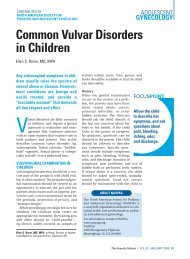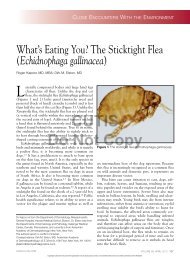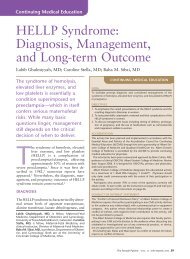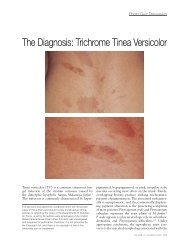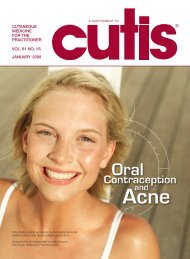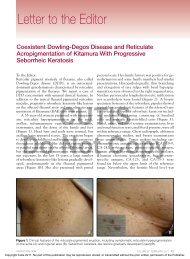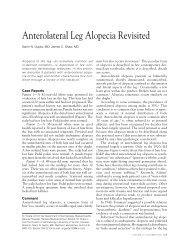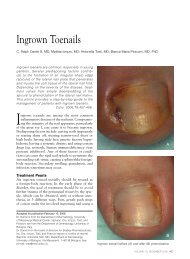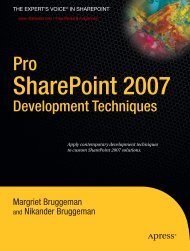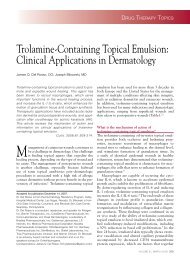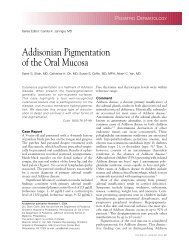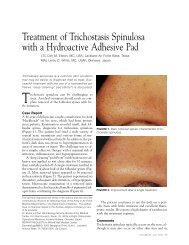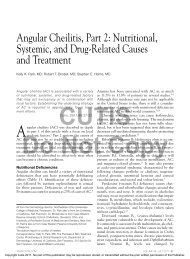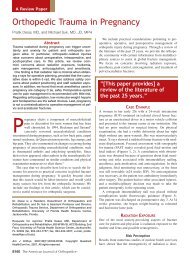Basics of Patch Testing for Allergic Contact Dermatitis - Cosmetic ...
Basics of Patch Testing for Allergic Contact Dermatitis - Cosmetic ...
Basics of Patch Testing for Allergic Contact Dermatitis - Cosmetic ...
You also want an ePaper? Increase the reach of your titles
YUMPU automatically turns print PDFs into web optimized ePapers that Google loves.
<strong>Patch</strong> testing basics 163<br />
readings are recommended <strong>for</strong> metals and topical<br />
antibiotics. 5<br />
There are many variations <strong>of</strong> this scheduled protocol and much<br />
controversy regarding the optimal time to interpret patch tests.<br />
<strong>Patch</strong>-Test Readings<br />
Reactions can vary from very mild (redness) to severe (vigorous<br />
reactions). The degree <strong>of</strong> reaction should be documented.<br />
Grading schemes <strong>for</strong> patch-test reactions vary. An<br />
example is the grading scale <strong>for</strong> reading patch tests at Mayo<br />
Clinic is as follows:<br />
Negative: normal-appearing skin<br />
1 reaction (very mild): macular erythema (Figure<br />
4A)<br />
2 reaction (mild): weak, nonvesicle, erythema, infiltrated,<br />
questionable papules<br />
3 reaction (moderate): strong, edematous, or vesicular<br />
(Figure 4B)<br />
4 reaction (severe): extreme, spreading, bullous, ulcerative<br />
(Figure 4C)<br />
It is important to note that certain fabric dyes may stain the<br />
skin. These stains, however, should not be interpreted as<br />
positive reactions (Figure 5).<br />
Patients should not read their own patch tests because <strong>of</strong><br />
the potential <strong>for</strong> error in identifying allergens causing the<br />
reactions.<br />
Allergens Associated With Strong Reactions<br />
Certain allergens on the standard series are known to give<br />
dependably strong reactions on patch testing in allergic patients.<br />
6 These include mixed dialkyl thioureas 1% pet, tixocortol-21-pivalate<br />
1% pet, ethylenediamine dihydrochloride<br />
1% pet, sesquiterpene lactone mix 0.1% pet, nickel sulfate<br />
2.5% pet, bacitracin 20% pet, thimerosal 0.1% pet, epoxy<br />
resin 1% pet, colophony 20% pet, mercaptobenzothiazole<br />
1% pet, and gold sodium thiosulfate 0.5% pet.<br />
Figure 3 <strong>Patch</strong>-testing protocol. (A) The standard allergen series is<br />
applied to a patient’s back on day 1. (B) Finn chambers are removed<br />
on day 3. After 15 minutes, patch-test reactions are read and graded.<br />
No distinct reactions were apparent <strong>for</strong> this patient. (C) <strong>Patch</strong>-test<br />
readings are repeated on day 5. Multiple reactions <strong>for</strong> this patient<br />
indicated allergy to <strong>for</strong>maldehyde and <strong>for</strong>maldehyde releasers.<br />
Allergens Associated With Weak Reactions<br />
Certain “problematic” allergens may be associated with a disproportionately<br />
large number <strong>of</strong> weak, irritant, and questionable<br />
reactions. 6 In the standard series, these include cocamidopropyl<br />
betaine 1% aqueous (aq), benzalkonium chloride<br />
0.1% aq, jasmine absolute 2% pet, iodopropynyl butylcarbamate<br />
0.1% pet, 2-bromo-2-nitropropane-1, 3-diol 0.5%<br />
pet, methyldibromo glutaronitrile 0.4% pet, methyldibromo<br />
glutaronitrile/phenoxyethanol 2% pet and 2.5% pet, dimethylol<br />
dihydroxyethyleneurea 4.5% aq, and clobetasol-17-<br />
propionate 1% pet.<br />
Interpretation <strong>of</strong> <strong>Patch</strong>-Test Reactions<br />
Ultimately, patch testing aims to identify relevant allergic<br />
patch-test reactions, with avoidance <strong>of</strong> the identified allergens<br />
facilitating resolution <strong>of</strong> the dermatitis. To ascertain relevance,<br />
all possible allergen exposures in the setting <strong>of</strong> home,<br />
hobbies, and occupation should be reviewed. Overall clinical



